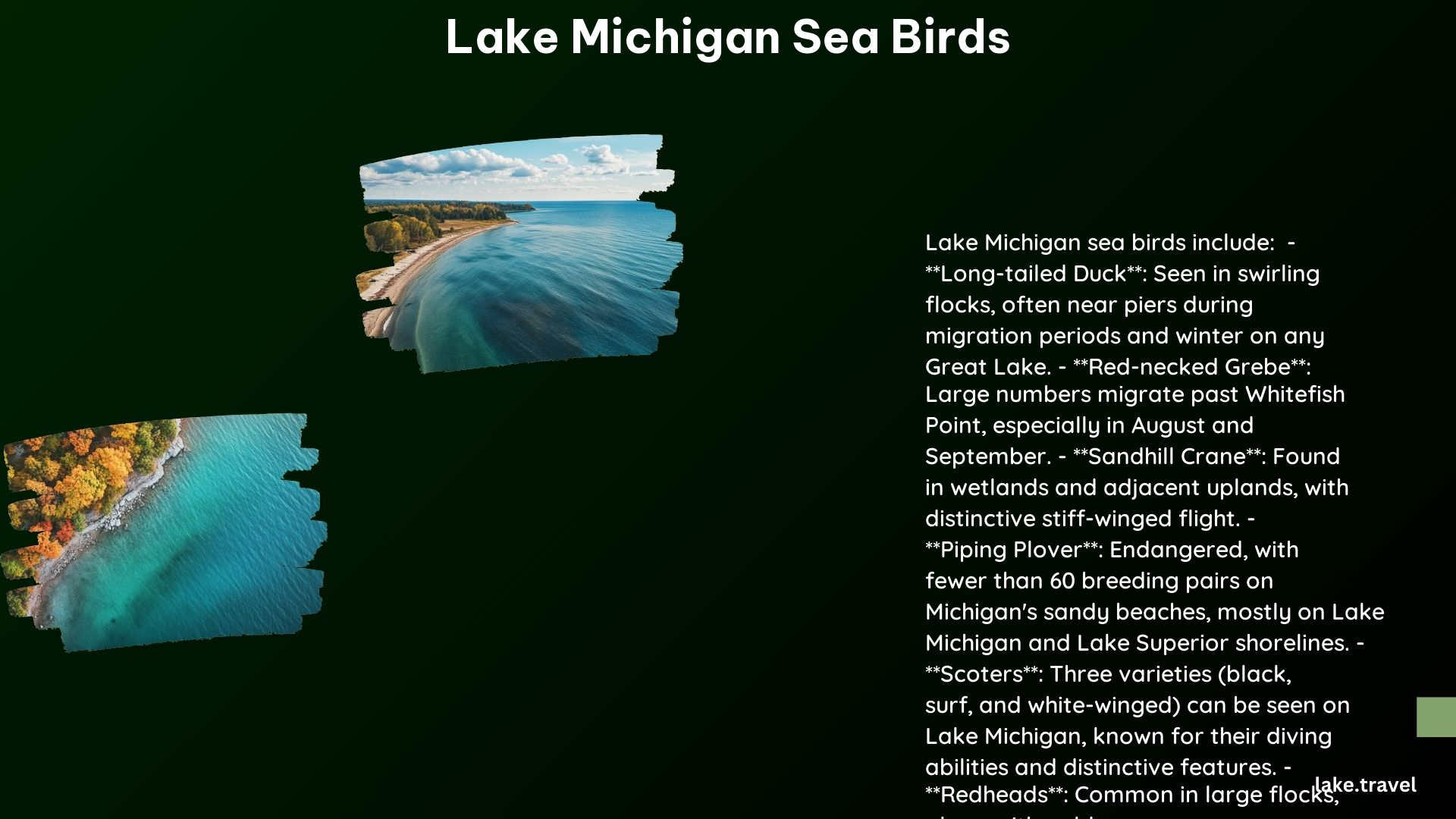Lake Michigan is a vital habitat for a diverse array of sea birds, including ducks, grebes, and shorebirds. Whether you’re an avid birder or simply enjoy observing the natural beauty of the Great Lakes, understanding the unique characteristics and migration patterns of these feathered inhabitants can enhance your appreciation of the region.
Long-tailed Duck

The Long-tailed Duck is a common sight on the open waters of Lake Michigan, particularly during the spring and fall migration periods. These diving ducks are known for their distinctive long, pointed tails and striking plumage that changes dramatically between breeding and non-breeding seasons.
- Habitat: Long-tailed Ducks are typically found on the open waters of Lake Michigan, often congregating near piers and other structures during the winter months.
- Migration: These birds are seen in large flocks during the April/May and October/November migration periods, as they travel between their breeding grounds in the Arctic and their wintering areas on the Great Lakes.
- Wintering: Long-tailed Ducks can be observed on Lake Michigan throughout the winter, providing a delightful sight for birdwatchers and nature enthusiasts.
Red-necked Grebe

The Red-necked Grebe is another species that can be spotted on Lake Michigan, particularly during the fall migration. These graceful birds are known for their striking breeding plumage, which features a distinctive reddish-brown neck and black-and-white head.
- Migration: Large numbers of Red-necked Grebes can be observed migrating past Whitefish Point, especially in August and September, as they travel between their breeding grounds in Canada and their wintering areas on the Great Lakes.
- Statewide Distribution: While the main migration route is along the eastern shore of Lake Michigan, smaller numbers of Red-necked Grebes can be found throughout the state during the spring and fall migrations.
Sandhill Crane
The Sandhill Crane is a majestic bird that can be spotted in wetlands and adjacent uplands along the shores of Lake Michigan, including areas near interstate highways.
- Habitat: Sandhill Cranes are found in wetlands and adjacent uplands, often congregating at favored sites during their spring and fall migrations.
- Migration: These large, graceful birds can be seen in flocks as they gather at sites like the Haehnle Sanctuary to rest and feed during their migrations.
Piping Plover
The Piping Plover is a shorebird that breeds on the sandy beaches of Lake Michigan and Lake Superior, making it a unique and important species to the region.
- Habitat: Piping Plovers breed on sandy beaches, primarily on the shorelines and islands of Lake Michigan and Lake Superior.
- Conservation Status: The Piping Plover is classified as Endangered by the U.S. Fish and Wildlife Service, with fewer than 60 breeding pairs remaining in Michigan. Habitat loss and fragmentation due to human activities have contributed to the decline of this species.
Best Times to Spot Migratory Birds
The best times to observe the diverse array of sea birds on Lake Michigan are during the spring and fall migration periods:
- Spring Migration: March to May, with peak activity in April, as birds travel northward to their breeding grounds.
- Fall Migration: August to November, with peak activity in September and October, as birds return to their wintering areas.
Human Impact on Habitats
The habitats of Lake Michigan’s sea birds are under threat from various human activities, including:
- Habitat Loss and Fragmentation: Coastal development and the introduction of invasive species have led to the loss and fragmentation of important breeding and feeding grounds for shorebirds like the Piping Plover.
- Climate Change: Rising water levels and changing weather patterns due to climate change are also impacting the habitats and migration patterns of these birds.
Birding Events and Resources
For those interested in observing and learning more about the sea birds of Lake Michigan, there are several events and resources available:
- The Biggest Week in American Birding: An annual one-week birding festival held in northwest Ohio, attracting over 90,000 people to observe the spring migration.
- Audubon Great Lakes: This organization provides resources and information for birding and conservation efforts in the Great Lakes region.
- The Nature Conservancy: This non-profit works to protect and improve bird habitats across the Great Lakes states.
By understanding the unique characteristics and migration patterns of Lake Michigan’s sea birds, you can enhance your appreciation of the region’s natural beauty and contribute to the conservation efforts that protect these important species.
References
- https://abcbirds.org/blog/michigan-birds/
- https://publish.illinois.edu/illinois-beach/illinois-beach-state-park/birds/
- https://gl.audubon.org/birds
- https://www.wisducks.org/sea-ducks-of-freshwater-lake-michigan/
- https://www.nature.org/en-us/about-us/where-we-work/priority-landscapes/great-lakes/stories-in-the-great-lakes/great-lakes-birds/
